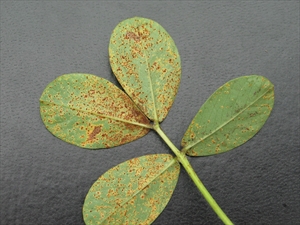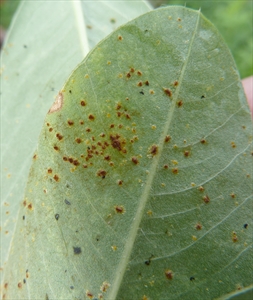Peanut rust
Pacific Pests, Pathogens, Weeds & Pesticides - Online edition
Pacific Pests, Pathogens, Weeds & Pesticides
Peanut rust (034)
Puccinia arachidis
Asia, Africa, North, South and Central America, the Caribbean, Oceania. It is recorded from Australia, Fiji, Palau, Papua New Guinea, Samoa, Solomon Islands, Tonga, and Vanuatu.
Peanuts, and other plants belonging to the genus Arachis.
The rust infects leaves, petioles, pegs (the shoots that grow into the ground) and stems (Photo 1). On the leaves, the spots are at first yellow, rapidly turning orange and then red-brown as masses of spores develop and break through the leaf surface. The lower surface produces the most spores (Photos 2&3).
The spread of rust depends on wind to disperse the spores, and humidity to provide conditions for infection at the leaf surface.
Infection causes leaves to turn yellow (Photo 1), dry, curl and wither. It is not known what losses occurs in Pacific island countries, but it is likely that yields are reduced by 50%, probably much more. Infected plants mature 2-3 weeks earlier than those that remain healthy.
Once infections occur, rust develops very rapidly, faster than early and late leaf spot diseases (see Fact Sheet No. 36 ).
Inspect plants regularly, at least twice a week, looking for leaves that are turning yellow before their time, with red-orange spots on the underside.
CULTURAL CONTROL
Cultural control is important, but note that rusts only survive in living plants; they do not survive in crop remains or in the soil. Spores are spread in moist, warm air, and periods of cloudy wet weather favour outbreaks of the disease. Conditions in most Pacific island countries are ideal for this disease. The following should be done:
Before planting:
- Plant new crops as far away as possible from older crops, especially those with rust infections.
- If it is not possible to avoid planting near older crops, do not plant downwind from them; otherwise, spores will easily spread to the new crop.
- Remove any volunteer plants from the last crop.
During growth:
- It is important to inspect the crop regularly, at least twice a week, if growing peanuts for the market, and you intend to use a fungicide to control the disease. Do not wait until the plants are heavily infected before applying fungicide.
After harvest:
- Collect debris and destroy by burning. The rust fungus will not remain alive in old vines or in the soil, but will survive on volunteer plants - those that are self-sown.
RESISTANT VARIETIES
There are breeding programs at ICRISAT, the International Crops Research Institute for the Semi-Arid Tropics, the USA and Australia, to produce varieties with tolerance to rust and late leaf spot. One such variety from Australia is Sutherland. On this variety, the appearance of rust pustules is delayed, they are smaller and produce fewer spores. Several varieties have been imported by Papua New Guinea and Solomon Islands in recent years. Enquire whether these new varieties are available in your country.
CHEMICAL CONTROL
- Carry out regular inspections.
- Begin to spray as soon as rust spots are seen, even if they appear on only one or a few plants. Spray at regular intervals: 10-14 days is best, continuing until 14 days before harvest.
- Spray more often if the first treatment is late, and there are many plants with rust spots. In most cases, spraying should begin no later than 30-35 days after planting.
- Use chlorothalonil. It is effective against rust, and also leaf spot diseases (see Fact Sheet no. 36).
____________________
When using a pesticide, always wear protective clothing and follow the instructions on the product label, such as dosage, timing of application, and pre-harvest interval. Recommendations will vary with the crop and system of cultivation. Expert advice on the most appropriate pesticide to use should always be sought from local agricultural authorities.
AUTHORS Helen Tsatsia & Grahame Jackson
Information from DAF (2018) Rust. Queensland Government. (https://www.daf.qld.gov.au/business-priorities/agriculture/plants/crops-pastures/broadacre-field-crops/managing-peanut-diseases/rust); and CABI (undated) Ground leaf rust Puccinia arachidis. Plantwise Knowledge Bank. (https://www.plantwise.org/knowledgebank/datasheet/45745#DistributionSection); and from Korus KA, Dufault N (undated) Peanut rust fungus: Puccina arachidis Speg. UF/IFAS Extension (https://sfyl.ifas.ufl.edu/media/sfylifasufledu/alachua/word/images/pdf/Peanut-Rust.pdf). Photo 4 McKenzie E (2013) Puccinia arachidis PaDIL - (http://www.padil.gov.au).
Produced with support from the Australian Centre for International Agricultural Research under project PC/2010/090: Strengthening integrated crop management research in the Pacific Islands in support of sustainable intensification of high-value crop production, implemented by the University of Queensland and the Secretariat of the Pacific Community.







